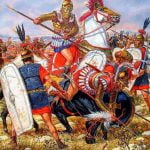Chapters
Seleucid War with Antiochus III was a clash between the ancient Romans and the Seleucid Empire of Antiochus III for the rule over divided Greece.
The Seleucids, part of the once united and powerful empire of Alexander the Great, founded their state in today’s Turkey. Initially, they did not gain a significant role in the Middle East region. However, with the reign of Antiochus III, later called the Great, the territory expanded significantly. His increasingly bold war campaigns alarmed the Roman Senate. The issue of Lysimachia, located in Europe, became a flashpoint. Until now, Antiochus conquered areas outside Europe, which did not cause any clear clashes with Rome. However, when Antiochus III entered the Chersonesos Thracian, where he began to rebuild Lysimachia, destroyed by the Thracians, the Romans became deeply concerned. Seleucid’s actions gave him control over the crossings to Asia, which significantly strengthened his strategic position. Rome, however, could not intervene at that time mainly because of its involvement in the Macedonian war.
The situation changed in 197 BCE when the conflict in Greece ended. With their hands untied, the Romans began to dictate terms to Antiochus. At the meeting in Lysimachia, both sides failed to reach an agreement. After this meeting, it became clear that war was inevitable, especially at the court of Antiochus in 195 BCE. Hannibal arrived, being Rome’s first enemy. It had a bad effect on the relations between the two countries. The situation was additionally aggravated by the case of Egypt and Greek cities, which were the targets of the expansion of the Antiochus monarchy.
After the defeat of Philip V in the Second Macedonian War, Rome’s role in the Peloponnesian Peninsula clearly increased. Many cities began to protest against such broad powers of the Romans. The Aetolians clearly opposed the Roman order. Disappointed with the lack of rewards for helping the Romans in their conflict with Philip V, they began to sow anti-Roman ferment, and it was in Antioch that they saw the one who would bring the Romans to their knees. In 193 BCE The League of Etols eventually allied with the Seleukid king and persuaded him to attack. Antiochus promised to free the Greeks from the Romans, immediately sending his army to the territory of the peninsula. The Greek question was once again the cause of the conflict.
As it turned out, contrary to the declarations of the Ethols, the army of Antiochus was not enthusiastically supported by the Greek cities. On the side of Rome, in turn, there were two valuable allies: the League of Achaia and Philip V, where the latter was forced to support the Romans. Initially, the king was most troubled by the lack of a large army that was unable to win more widely. Antiochus counted on the support of Greek cities, but as I have already written, few decided to openly help the Syrians. This situation resulted mainly from the fact that the Greek world was politically divided.
In 191 BCE A consular army under the command of Manius Acylius Glabrion arrived in Greece and, having joined with the Roman troops already operating in Greece, forced Antiochus to withdraw. In April, there was the Battle of the Thermopylae where Antiochus III was defeated by the overwhelming Roman forces. The king’s defeat was caused by his position being circumvented by the Roman unit of Marcus Porcius Cato, who, using a hidden passage in the mountains, attacked the Syrian camp, stirring up confusion in Seleucid’s army. The defeated Seleukid ruler left Greece, preparing for the final deal with Rome.
The Aetolian War (191-189 BCE)
The situation of the Romans at sea was much worse at the beginning of the war than on land. Gradually, however, Seleucida began to lose its advantage, especially when the island of Rhodes, famous for its excellent ships and sailors, sided with Rome. In September 191 BCE Antiochus’ fleet was defeated at the Battle of Korykos. Eventually, Antiochus’ reign at sea ended with two victories by the Romans: at Side and at Myonnesos. This fact allowed the Roman state to freely transport the army to Asia and attack the heart of the monarchy.
Simultaneously with the victories at sea, the Romans continued their land campaign. The Roman army under the command of Lucius and Publius Cornelius Scipio captured the undefended Lysimachia, and then freely crossed to Asia Minor via the unprotected Hellespont (the strait connecting the Aegean Sea and Marmara). The appearance of a not very strong Roman military contingent in the territory of the Seleucid state was an excellent opportunity for Antiochus to finally defeat the state of Italy. In December 190 BCE one of the greatest battles of the ancient world took place near Magnesia. Twice as strong army of Antiochus, numbering 70,000 soldiers, suffered a total defeat. The defeat forced Antiochus to conclude a truce.
Consequences
The ruler of the Seleucid dynasty gave up the lands in Asia Minor above the Taurus Mountains, gave his son a hostage, and agreed to pay a contribution of 15,000 talents. In addition, the Seleukid fleet was reduced to a few ships, the use of war elephants was forbidden, and the Monarchy was not allowed to make alliances and spend wars. The provisions of the truce were finally included in the peace treaty in 188 BCE. in Apamea. It was the end of the glory of this country.
A far-reaching result of the defeat of Antiochus was certainly the final collapse of the state in 63 BCE when Pompey the Great finally conquered the monarchy and turned it into a Roman province.








